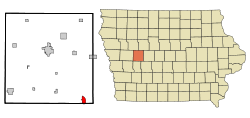Coon Rapids, Iowa
| Coon Rapids, Iowa | |
|---|---|
| City | |
 Location of Coon Rapids, Iowa |
|
| Coordinates: 41°52′21″N 94°40′36″W / 41.87250°N 94.67667°WCoordinates: 41°52′21″N 94°40′36″W / 41.87250°N 94.67667°W | |
| Country | United States |
| State | Iowa |
| Counties | Carroll, Guthrie |
| Incorporated | November 2, 1882 |
| Area | |
| • Total | 1.78 sq mi (4.61 km2) |
| • Land | 1.78 sq mi (4.61 km2) |
| • Water | 0 sq mi (0 km2) |
| Elevation | 1,175 ft (358 m) |
| Population (2010) | |
| • Total | 1,305 |
| • Estimate (2012) | 1,287 |
| • Density | 733.1/sq mi (283.1/km2) |
| Time zone | Central (CST) (UTC-6) |
| • Summer (DST) | CDT (UTC-5) |
| ZIP code | 50058 |
| Area code(s) | 712 |
| FIPS code | 19-16050 |
| GNIS feature ID | 0455613 |
Coon Rapids is a city in Carroll and Guthrie counties in the U.S. state of Iowa. The population was 1,305 at the 2010 census unchanged from the 2000 census. The small portion of Coon Rapids that lies in Guthrie County is part of the Des Moines–West Des Moines Metropolitan Statistical Area.
Wheeling and dealing in public land marked the emergence of Carroll county. The county seat, Carrollton, was built on land given by two Fort Des Moines speculators. Two savvy Carrollton residents, Crocket Ribble and Jacob Cretsinger decided to try their hand in real estate. They purchased land along the Middle Racoon River, built a saw and grist mill and went into business in 1864. Between the impact of the Civil War and later national panics, frontier settlement slowed down. However, the partners were able to establish a post office, named Coon Rapids; become a stop on stage coach service to Sioux City. Returning civil war veterans, William Minnich and his brother in law, Michael Shettler saw potential in the hamlet. After purchasing land, they submitted a plat for the village of Coon Rapids and built what would become a store-hotel and home for the Shettler family. Minnich maintained his farm in adjoining Guthrie County. Between 1870 and 1880, the hamlet grew as former farmers became merchants and tradesmen and newcomers came to the area. In addition to the Mill, the town had several general stores offering an array of goods, a hardware store, implement dealer and the all important real estate agent.
When the Chicago, St Paul and Milwaukee started to build a railine about a half mile south west of the hamlet, they established a rough and tumble camp for their workers, many of whom were accompanied by their families. The railroad project provided jobs and good money for local boys and newcomers. A boom began. Between 1880 and 1886, merchants in the village of coon rapids literally moved their buildings into what the railroad had platted as a town. Main street slowly became lined with business houses and homes and the area between the old and new towns slowly was transformed into a residential area. The editor of the newly established newspaper, Coon Rapids Enterprise, bemoaned the lawlessness and intemperate behavior found in the new town. Selling liquor seemed to be the primary business! However, the town grew, nearly doubling in population and the new commercial center by the railroad expanded with a variety of new and old businesses. 1886 could have marked the end of Coon Rapids. A tornado ripped across western Iowa and Coon Rapids was in its path. The eastern part of town was demolished. Fortunately, only two in town had died, but the property damage within town and along the tornados route was immense. Help poured in from around the United States and the town rebuilt. However, this wooden frontier community was vulnerable to fire. Between 1887 and 1894, a multitude of fires occurred some caused by arson, others by lightning, and others the result of cinders from flues igniting dry, shingled roofs.
...
Wikipedia
